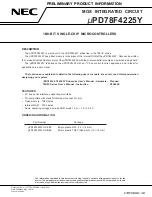
11
LT1425
APPLICATIO
N
S I
N
FOR
M
ATIO
N
W
U
U
U
R
OCOMP
, the external resistor value required for its nomi-
nal compensation:
1
1 – DC
)
)
R
OUT
= ESR
∆
V
RCCOMP
∆
I
SW
)
)
R
FB
R
OUT
)
)
R
OCOMP
= K1
While the value for R
OCOMP
may therefore be theoretically
determined, it is usually better in practice to employ
empirical methods. This is because several of the required
input variables are difficult to estimate precisely. For
instance, the ESR term above includes that of the trans-
former secondary, but its effective ESR value depends on
high frequency behavior, not simply DC winding resis-
tance. Similarly, K1 appears to be a simple ratio of V
IN
to
V
OUT
times (differential) efficiency, but theoretically esti-
mating efficiency is not a simple calculation. The sug-
gested empirical method is as follows:
Build a prototype of the desired supply using the
eventual secondary components. Temporarily ground
the R
CCOMP
pin to disable the load compensation func-
tion. Operate the supply over the expected range of
output current loading while measuring the output
voltage deviation. Approximate this variation as a single
value of R
OUT
(straight line approximation). Calculate a
value for the K1 constant based on V
IN
, V
OUT
and the
measured (differential) efficiency. They are then com-
bined with the data sheet typical value for (
∆
V
RCCOMP
/
∆
I
SW
) to yield a value for R
OCOMP
.
Verify this result by connecting a resistor of roughly this
value from the R
OCOMP
pin to ground. (Disconnect the
ground short to R
CCOMP
and connect the requisite
0.1
µ
F filter capacitor to ground.) Measure the output
impedance with the new compensation in place. Modify
the original R
OCOMP
value if necessary to increase or
decrease the effective compensation.
Once the proper load compensation resistor has been
chosen, it may be necessary to adjust the value of the
R
FB
resistor. This is because the load compensation
system exhibits some nonlinearity. In particular, the
circuit can shift the reference current by a noticeable
SELECTING R
FB
AND R
REF
RESISTOR VALUES
The expression for V
OUT
developed in the Operation
section can be rearranged to yield the following expres-
sion for R
FB
:
V
OUT
+ V
F
+ I
SEC
(ESR)
V
BG
) )
)
)
R
FB
= R
REF
α
N
SP
The unknown parameter
α
, which represents the fraction
of R
FB
current flowing into the R
REF
node, can be repre-
sented instead by specified data sheet values as follows:
V
BG
(I
REF
)(3k)
)
)
(I
REF
)(
α
)(3k) = V
BG
α
=
Allowing the expression for R
FB
to be rewritten as:
V
OUT
+ V
F
+ I
SEC
(ESR)
I
REF
(3k)N
SP
)
)
R
FB
= R
REF
where,
V
OUT
= Desired output voltage
V
F
= Switching diode forward voltage
(I
SEC
)(ESR) = Secondary resistive losses
I
REF
= Data sheet reference current value
N
SP
= Effective secondary-to-primary turns ratio
Strictly speaking, the above equation defines R
FB
not as an
absolute value, but as a ratio of R
REF
. So the next question
is, “What is the proper value for R
REF
?” The answer is that
R
REF
should be approximately 3k. This is because the
LT1425 is trimmed and specified using this value of R
REF
.
If the impedance of R
REF
varies considerably from 3k,
additional errors will result. However, a variation in R
REF
of several percent or so is perfectly acceptable. This yields
a bit of freedom in selecting standard 1% resistor values
to yield nominal R
FB
/R
REF
ratios.
SELECTING R
OCOMP
RESISTOR VALUE
The Operation section previously derived the following
expressions for R
OUT
, i.e., effective output impedance and






































